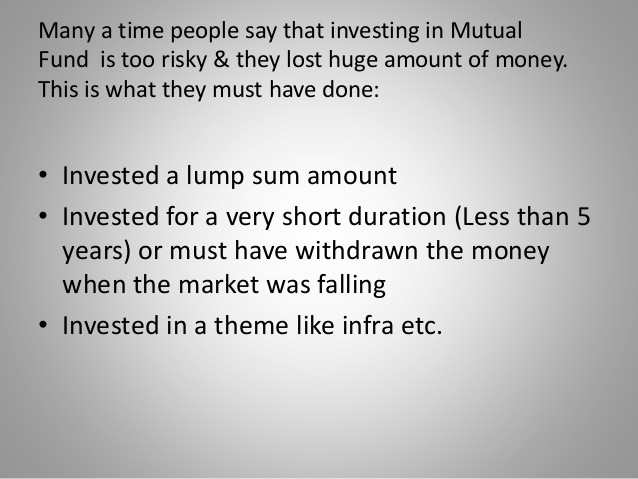Is Your Mutual Fund Too Risky
Post on: 31 Май, 2015 No Comment

JonnelleMarte
Investors have long measured their mutual funds against benchmarks like the Standard & Poor’s 500-stock index, content with a fund that could keep up with or top the index.
But when the broader market itself is unimpressive — or downright nightmarish — some pros say investors may need to rethink their standards. Instead of just focusing on returns, investors need to be conscious of the risk and volatility they expose themselves to along the way, advisers say.
Enter the Sharpe ratio, a measure that helps investors figure out how much return they’re getting in exchange for the level of risk they’re taking on.
A lot of folks just look at the return side of the equation, says vice president of equity investments for USAA Investments in San Antonio. But how smooth was your ride to get to that return? The Sharpe ratio puts those two pieces together.
Getting Paid for Risk
Created by Nobel laureate William Sharpe, a Stanford University finance professor, the ratio is intended to be a measure of what an investment returned for each unit of risk it carried. The top half of the ratio looks at what a fund returned over a set period and subtracts what an investor could have earned in a risk-free investment, typically defined as three-month Treasury bills, over that same period. The denominator is the fund’s standard deviation, which measures how much a fund strays from its average performance — in other words, its volatility.
The higher the ratio, the more an investor is compensated for the risk he takes on, says a research consultant for MORN, -1.76% ‘s Morningstar Investment Management unit.
Consider two hypothetical stock funds with similar returns. Fund A gained an average of 12% a year over the past three years, but had a standard deviation of 30%, giving it a Sharpe ratio of 0.4. Fund B returned an average of 10% over that same period but had a standard deviation of 20%, giving it a Sharpe ratio of 0.5. (With short-term Treasury yields near zero, the amount to be subtracted — the return on a risk-free investment — for now is basically zero.)
While Fund A had a better return, Fund B delivered more return for the amount of risk it took, says Mr. Blanchett.
Some portfolio managers say they aim to have certain Sharpe ratios on their funds, using it as a checkpoint of sorts to make sure a fund’s returns are in line with its risks.
Investors tend to have weaker stomachs during rocky markets, says head of global asset allocation for Putnam Investments, so having an easy way to compare investments on a risk-and-return basis can help them take emotion out of portfolio decisions.
It’s really about finding a good stable path, says Mr. Knight, who explains that he uses low-volatility stocks and options to help smooth out fund performance.
Useful Comparisons
For advisers and individual investors, Sharpe ratios, which Morningstar.com lists under a fund’s Ratings & Risk tab, can be a particularly useful tool for comparing funds with similar strategies. For instance, two funds can end up with identical returns but have very different ways of getting there, Mr. Blanchett says. The Sharpe ratio can help investors determine which fund is causing them to take on more risk.
Sharpe ratios work best when figured over a period of at least three years, advisers say. Looking at the fund’s risk-adjusted performance over several years offers insight on how the fund weathered different market environments, says a mutual-fund analyst with Fort Pitt Capital Group, a wealth-management firm based in Pittsburgh. For instance, a fund with an attractive Sharpe ratio over the past 10 years would have managed to bring in returns to compensate investors for the risk it took through the recession of the early 2000s, the subsequent boom years, the recession that started in 2008 and the volatility of last year.
You get more of a full market cycle, says Mr. Baish.
When used in conjunction with other measures, the Sharpe ratio can help investors develop a strategy that matches both their return needs and risk tolerance, advisers say. Mr. Baish, for instance, looks first at a fund’s performance to get a sense for whether it might produce the sort of returns his clients need. Then he will look at the Sharpe ratio to see which funds are taking on outsize risk to get those returns. Some, like small-cap funds, will require taking on more risk than others, he notes.
No Predictor
To be sure, the measure has its limitations: It can be difficult to interpret and use for comparisons in periods when some funds’ returns are below the Treasury-bill return or even negative. Investors should also keep in mind the Sharpe ratio is calculated using past performance, meaning it offers no guarantee on how a fund might behave in the future, says Mr. Blanchett.
But the ratio can be telling when comparing two funds that compete in the same category. For example, in Morningstar’s large-blend peer group, the $2.3 billion has a three-year Sharpe ratio of 1.3 through March, while the $413 million came in at 0.66. The Nuveen fund bested the Alpine offering in both components of the Sharpe ratio: It delivered higher returns over the period — an average of 22% a year versus 12% — and was less volatile, as measured by standard deviation.
An Alpine Funds spokesman says the international exposure in the Dynamic Dividend fund caused it to underperform its peers in the past several years. Nuveen declined to comment.
Ms. Marteis a reporter for SmartMoney.com. Email her at jonnelle.marte@dowjones.com .














